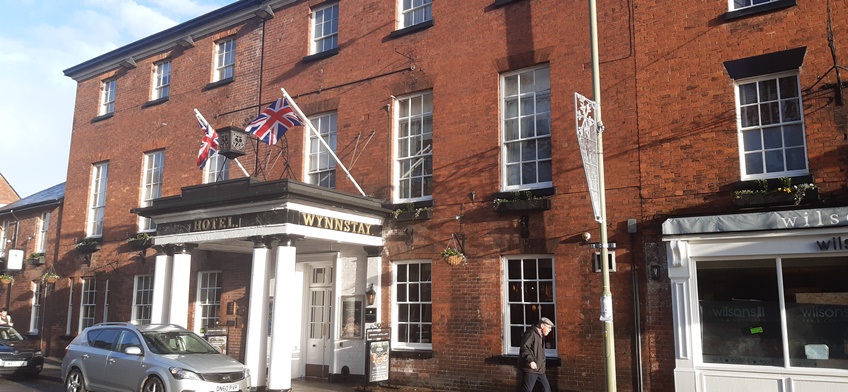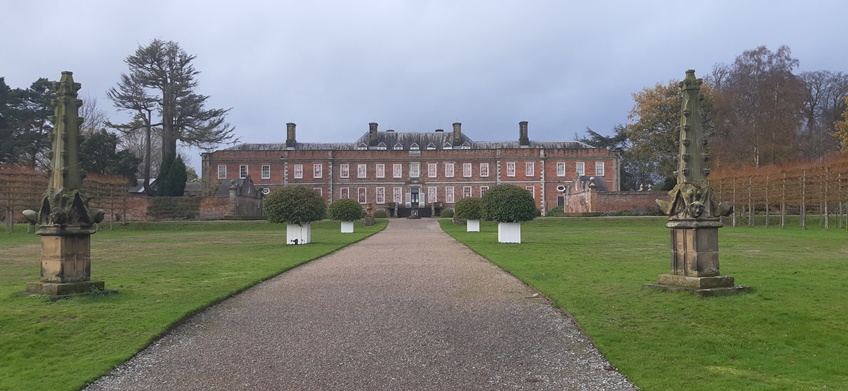by Nigel Heath
Probably the UK’s largest Advent Calendar was on display when my wife Jenny and I decided on a spur of the moment winter mini break.
We had driven up from our cottage, just outside Monmouth, and checked in to The Wynnstay, a lovely old Georgian Hotel in Oswestry, close to the Welsh border, early on a December Wednesday afternoon.
Oswestry is a great place to stay for those who enjoy visiting National Trust homes and gardens because Chirk Castle and Erddig Hall are close by and Powys Castle is just down the road in neighbouring Welshpool.
So, the following morning we made the twenty-minute drive to nearby Wrexham’s Erddig Hall, a late 17th century country mansion saved from dereliction in the 1970’s and here, to our surprise, we came across that giant Advent Calendar!
The hall, built in the 1680’s has over thirty large east-facing windows, just perfect for a giant calendar with twenty-four of them being revealed in turn to at last unveil a creative illustration by local school children.
But that was not all, because a twinkling festive grotto has been created where Santa will be greeting children in exchange for donations to the local food bank.

He had yet to fly in on his sleigh from the North Pole when we visited and his customary chair was empty, so National Trust volunteers Alison Jones and Sharon Roberts, who were in charge of admissions to the hall, took his place in my picture.
Santa’s grotto has been a special feature of Erddig Hall’s Christmas festivities for the past eight or so years and over that time an amazing seven tonnes of food items had been donated, they revealed.
The hall’s lavishly furnished upper floors, containing an amazing thirty thousand items collected by its former owners, the Yorke family were closed.
But a tour of the servants’ quarters, on the ground floor, gave us a fascinating insight into the world below stairs because, beginning in 1791, their lives were recorded in portraits and pictures over the next two hundred years, as a mark of respect for their loyalty and length of service.
In fact, Erddig with its preserved servants’ rooms, laundry, bakehouse, sawmill and smithy has been described as the most evocative “Upstairs Downstairs” house in Britain.
After touring the ground floor, we came back out into the extensive gardens and by great good fortune, chanced upon Glyn Smith, who has been Erddig’s Head Gardener for the past 35 years
He was accompanied by Carl Wassell, who had retired from a career with the NHS and become a volunteer before joining Glyn and two other colleagues as a full-time gardener.
There was not much to see at the moment, but it was the very structure of the garden that took centre stage at this bleak time of the year, said Glyn.
I pointed out the two long and skeletal lines of pleached limes that had taken the place of old walls in much earlier times and was not really surprised to learn that it took skilled members of his team ten weeks to prune them over winter.
But I was amazed when he told me that the mammoth task involved some 65,000 individual cuts by hand with secateurs.
‘I suppose it’s a fine example of man’s mastery over nature,’ he said
The Gardens, dating back to the 16th and 17th century, were extremely rare, explained Glyn, who described Erddig Hall as the missing link between the earlier style of walled gardens as private family spaces, and the more open style of landscaped gardens which were less expensive to maintain.
While the hall’s herbaceous borders and bedding plants took centre stage in the summer, the estate also grew some two hundred varieties of cooking and eating apples sold in the autumn to raise funds and later offered to visitors in exchange for small donations.
And what were the main satisfactions of his role? I asked.
It was being able to maintain the gardens to a high standard for future generations to enjoy while at the same time helping to train and inspire the young gardener of tomorrow, he said.

Unfortunately, stunning Chirk Castle, which dates back to 1298, and is only six miles from Oswestry, was closed, so we decided on afternoon wander around this ancient North Shropshire market town, close to the English-Welsh border.
Near our hotel, and also in Church Street, we could not help noticing St Oswald’s Church because it is the tallest, and possibly the oldest building in the town, with its solid square tower dating back almost one thousand years.
The origins of the town are uncertain, although the market dates back to 1190 and its name is thought to be a corruption of Oswald’s Tree because legend has it that Oswald the Christian King of Northumbria lost a great battle against the pagan king of Mercia, who had his body dismembered and hung in tree as a warning to others.
The town with its narrow passageway linking streets and selection of specialist and independent shops is definitely worth wandering around, but its monthly Friday artisan market proved rather a disappointment.
We set out from our hotel with shopping bags and high hopes, but maybe because the previous day had been pretty wet, it had dampened the spirits of the stall holders because there were not many of them about and few customers, even though by contrast it was a glorious Friday morning.
But never mind because we could look forward to a lovely cross country run back via Welshpool and be home in time for lunch.




